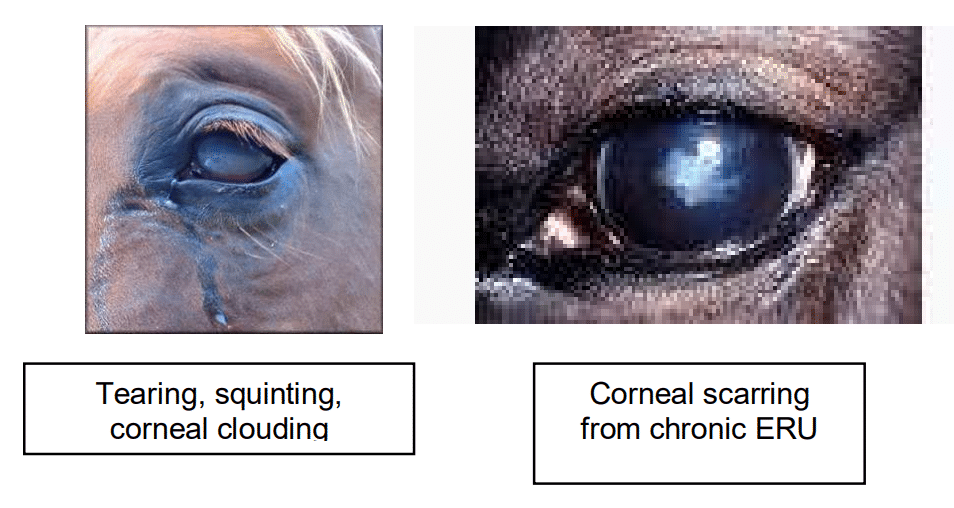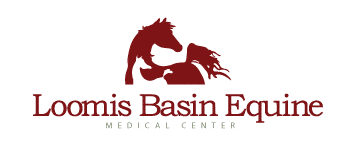
by Catherine Jacobs, DVM
Share:
ARTICLE: Equine Recurrent Uveitis "Moon Blindness"
What is Equine Recurrent Uveitis?
Equine recurrent uveitis (ERU), also known as “moon blindness” or periodic ophthalmia, is a common disease affecting the equine eye and is the most common cause of blindness in horses. Interestingly, due to the recurrent nature of the disease, the term “moon blindness” dates back to the 1600s when Egyptians believed the ailment was associated with phases of the moon. Today, however, ERU is recognized as an immune-mediated disease, meaning it is caused by an unspecified immune reaction. There are several causes that have been implicated such as bacteria (namely Leptospira), viruses, parasites (namely Onchocerca) and trauma. ERU, however, is most often considered to be an idiopathic disease, meaning no specific cause can be identified. ERU is strongly over-represented in Appaloosas, however it has been identified in other breeds.
How do I know if my horse may have ERU?
The first step in identifying ERU in your horse is to recognize the signs of ocular discomfort. These signs include squinting, tearing, redness, rubbing, discoloration of the iris, constriction of the pupil and clouding of the cornea. If you find that your horse has signs of ocular discomfort, it is important that you contact your veterinarian immediately. While these signs are seen with ERU, it is important to keep in mind that some of these are also seen with other ocular conditions such as corneal ulcers, conjunctivitis, glaucoma, foreign bodies and trauma. Your veterinarian must thoroughly assess the eye in order to determine whether the problem truly is ERU.

How does my veterinarian diagnose ERU?
The diagnosis of ERU begins with a thorough physical and ocular examination. The eye is examined with an ophthalmoscope to look for signs of uveitis such as “aqueous flare” which is the cardinal sign of the disease. Aqueous flare shows up as a hazy line over the cornea when using a slit beam light. This finding is seen as a result of proteins leaking into the aqueous humor due to inflammation. Additionally, the cornea should be stained with a fluorescein dye to determine if an ulcer is present. A tonometer, which is a device used to measure intraocular pressure (IOP), may also be used to aid in the diagnosis. Often, the IOP may be decreased in cases of uveitis. However, if your horse has concurrent glaucoma, the IOP will most likely be elevated. Your veterinarian may also elect to run routine bloodwork to rule out an underlying disease process. More advanced diagnostic techniques include ocular ultrasound to access all the structures in the eye.
Once a diagnosis has been made, there are several tests that can be done to try to determine the cause, however they are sometimes unrewarding given that most cases are idiopathic. These tests may involve blood samples to look for bacterial or parasitic antigens or a biopsy of the surrounding ocular tissues to evaluate for the presence of parasites.
What is the treatment of ERU?
If a cause of ERU can be identified, then one goal of treatment is to eliminate the cause (such as deworming or starting a course of antibiotics). Another extremely important goal of treatment is aimed at decreasing the ongoing damage that is associated with inflammation. There are several medications commonly used to treat ERU:
-
Topical steroid ointments: To help decrease inflammation and minimize the immune-mediated response. It is essential that your veterinarian rule out corneal ulcers before starting steroid therapy.
-
Topical NSAIDS: Also help decrease inflammation.
-
Topical atropine ointment: To dilate the pupil which decreases pain.
-
Systemic NSAIDS: To help decrease inflammation.
-
Systemic corticosteroids: A more potent method of calming the inflammatory response, however these drugs must be used with extreme caution in horses due to the risk of laminitis.

